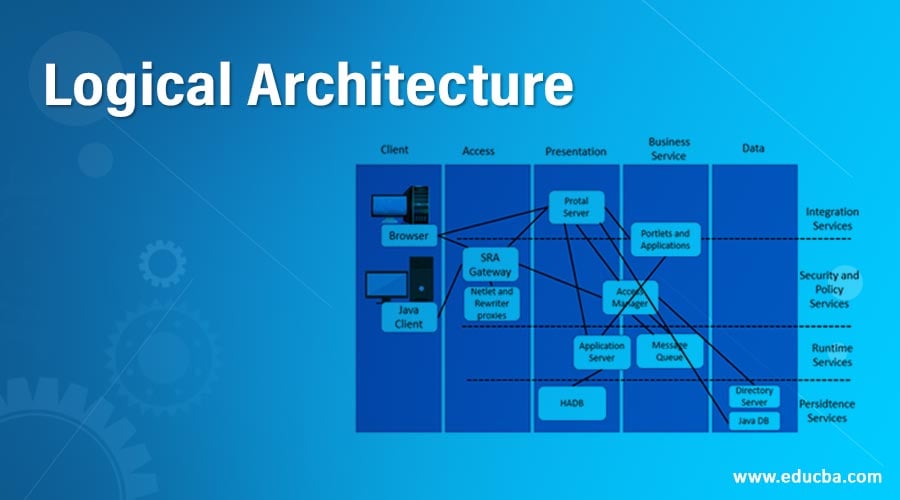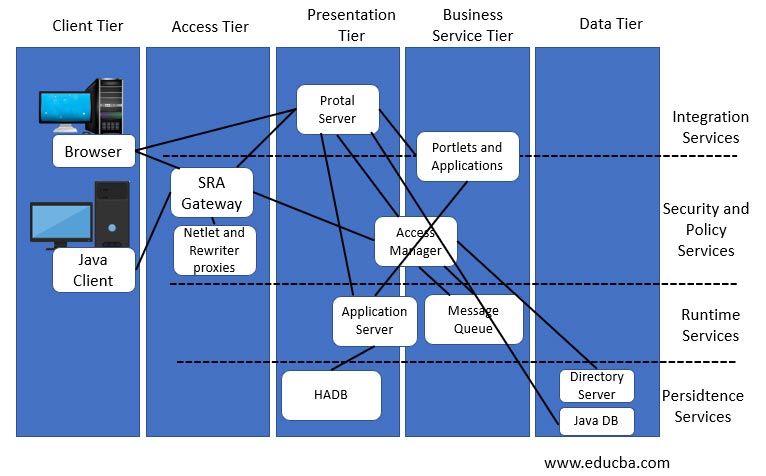Updated April 10, 2023
Introduction to Logical Architecture
The logical architecture is considered a type of structural design that is used to provide a detailed description of the system without defining the system technology or environment. It includes all the information related logically and detailed description without using technical terms in it. It means it can be considered a diagram used to define the relation between the software components. The main purpose of designing logical architecture is to plan for the system and use it for communication before designing and implementing the system. And by this diagram, the user can get an overview of the system.
Logical Architecture with Diagram
Diagram of logical architecture which is explained below:
The logical architecture is defined as the organization of the subsystems, software classes, and layers that make the complete logical system. The components are placed randomly in the system; that is why it is called logical architecture. The components can be deployed in physical computers and operating systems and can be used by the network. The system is decomposed into smaller logical components that directly interact with the system to meet the system requirements. The logical components are the components that are the abstraction of physical components, which means they can be used to perform complete system functionality while taking care of the system constraints. An example of a logical component is a user interface that is used by a web browser. The logical architecture acts as an intermediate between the physical architecture and the black box system. The logical architecture is created to define the interaction of operation with the system to be understood properly. The block diagram is generally used to represent the logical architecture and display the system’s operations logically. In the initial phase, the logical components are designed for the system, and then the logical architecture is created for the system. The logical architecture is considered the basic architecture for the system covering all the basic details regarding the system and includes complete information about the system. The logical architecture is decomposed into the different tier that helps to design the logical architecture diagram. The tiers include in the logical architecture are client tier, access tier, presentation tier, business service tier, and data tier. These all components help to design the complete logical architecture for any type of system.
Components of Logical Architecture
When the logical architecture diagram is created, it developed with more focused and have more concerned compare to physical architecture as this is the first step for designing the system, and if there is any relative error present in the system, it can create problems in implementing the system in the future. For a system, there is one common tier architecture is defined that contains three tiers that are used to defining the response-request cycle.
- The user uses the presentation tier to generate the request.
- The request is immediately transferred to the application tier.
- In the application tier, further processing is done, and the data is fetched from the data tier that is required in manipulation.
- The response is created by the application tier and transferred to the presentation tier.
- The response is transferred to the user using the presentation tier.
For creating the logical architecture, there are different types of components used to fulfill the user requirements that directly depend on the functions. In the logical architecture diagram, the components’ placing is in a horizontal dimension that represents the logical tiers.
In the below section, the components of a logical architecture diagram are discussed below:
1. Client
The client tier consists of the applications that the user uses for accessing the portal services. By this tier, the user is able to use the application and fulfill his requirements. The type of client tier is the browser or java client that helps the user to gain access to the applications.
2. Access
By this tier, the user is able to gain access to the organization network from any location. The user uses the internet service to enter into the organization system and use the system services. The access tier is in between the presentation tier and the client tier and acts as an intermediate for the communication between these two tiers. There is a requirement of a secure server to be granted only valid users, and authorized users can use the system.
3. Presentation
The presentation tier helps to provide access to the user to use the system and gain important information and fulfill their requirements. The presentation tier presents the response generated by the application tier and presents the result to the user. This tier is also capable of knowledge management, content management, community management, and collaboration management. The portal server type software issued for implementation of the presentation tier.
4. Business Service
The business service tier is responsible for handling the backend of the system and handling the mechanism that is used for presenting the result on the presentation tier. All the processing and main development work reside in this tier. The business service tier also contains application components and portlets that are deployed in the application server and web server. The business tier contains numerous applications that are: ERP (Enterprise Resource Planning) system, email systems, and calendar servers, and many more.
5. Data
The data tier is used as the storage tier used by the business service tier to store the persistent data and information in it. The storage components used by the data tier are Java DB and Directory Server. The data is stored that the presentation tier can be further used to present the result to the user and display the results to the user.
Conclusion
The logical architecture is a type of diagram used for designing the system and contains various components for designing the system. Through this architecture, detailed information can be collected about the system. The system does not transfer technical details, but logical architecture can understand the system’s overall flow.
Recommended Articles
This is a guide to Logical Architecture. Here we also discuss the introduction and components of logical architecture along with a diagram of logical architecture. You may also have a look at the following articles to learn more –




